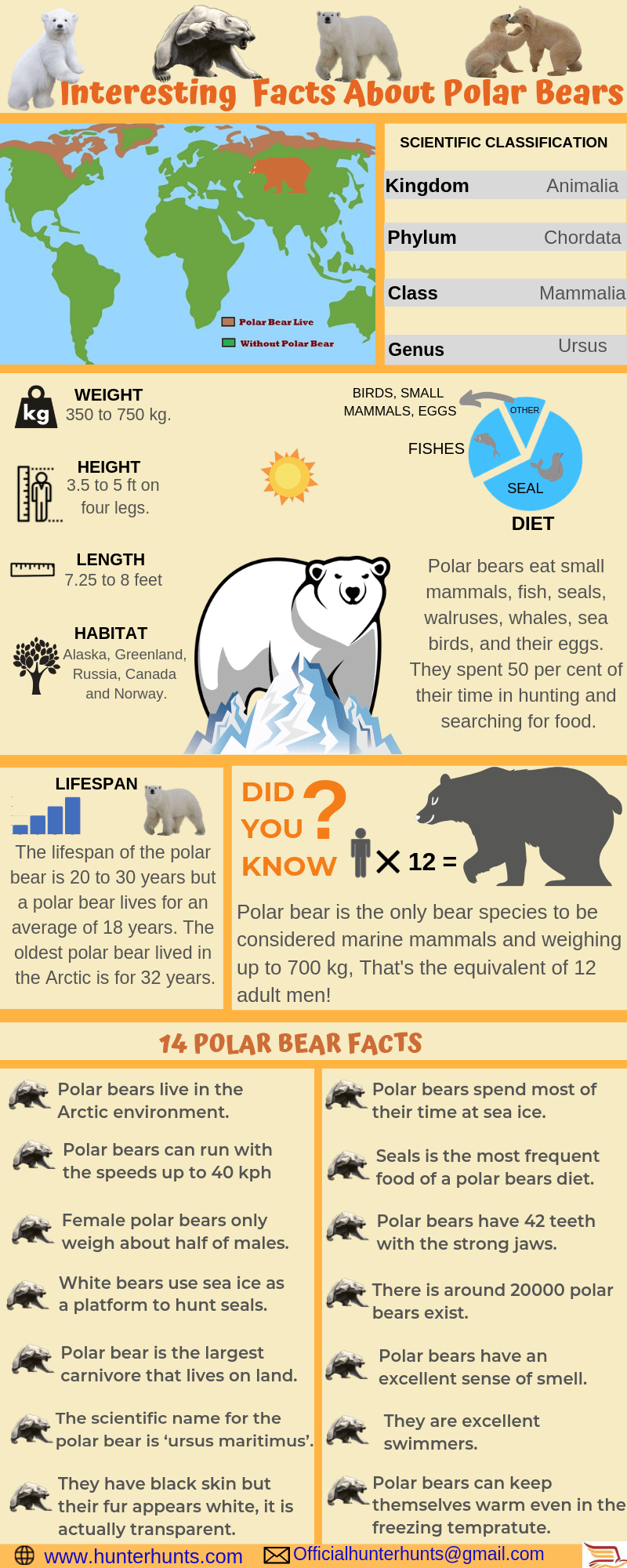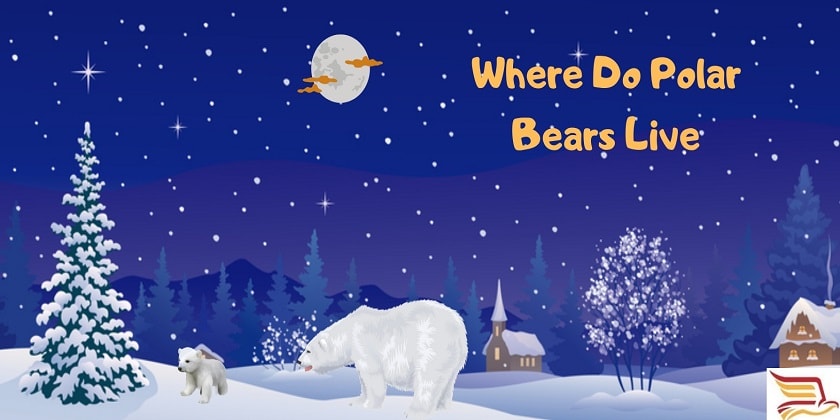You must be very well known to the white bear, generally called the polar bear. well, this animal of the ice habitat makes its identity very different than other bear species because of its survival stories.

In this article, we will discuss some very interesting polar bear facts for kids and enhance your knowledge about this ultimate survivor of the North Pole.
About Polar Bears
Polar bears are marine mammals and spend a lot of their time on Arctic Ocean ice. Polar bears live around the area of the Arctic Circle. Several diversifications build polar bears unambiguously suited to life in icy habitats. Their fur is thicker than the other bears’ and covers even their feet for heat and traction on ice.
A thick layer of blubber below their fur provides buoyancy and insulation. The long neck and slim bone of the Thalarctos maritimus most likely aid in streamlining the animal within the water while warming the air that they breathe, and their front feet are giant, flat, and oar-like, creating them glorious swimmers.

In fact, polar bears are the biggest land carnivores in the world, rivaled solely by the Kodiak brown bears of the southwestern American state. An interesting fact about polar bears is, that they sit at the highest of the organic phenomenon within the biologically made Arctic. The Polar bears eat harp and hooded seals, sea birds, walruses, beluga whales, bowhead whale carcasses, and vegetation rarely.
However, because of expected surroundings loss caused by temperature change, the ice bear is classed as a vulnerable species. One of the very interesting polar bear facts is that, for many years, large-scale looking raised international concern for the longer term of the species. However, populations rebounded when controls and quotas began to require a result.
Furthermore, for thousands of years, the ice bear has been a key figure within the material, spiritual, and cultural life of circumpolar peoples, and polar bears stay vital in their cultures. Traditionally, the ice bear has additionally been called the white bear. There are not only 2 or 3 interesting facts about polar bears, there are numerous, but we will cover some very important ones.
Astonish Polar Bear Facts: You Need To Know
20 Interesting Polar Bear Facts
- The polar bear is the largest species of bear.
- They live in the frozen surroundings of the Arctic Ocean: Canada, Alaska (US), Greenland, Russia, and Norway.
- According to the International Union for Conservation of Nature, the population is only 20,000-25,000 polar bears in the world.
- The DNA of polar bears can be extracted just by their footprints.
- One of the fun polar bear facts for kids, they clean themselves by rolling in the snow.
- The weight of a male polar bear reaches up to 1200 pounds.
- A polar bear can live for 10 days without eating.
- Seal is the favorite food of polar bears.
- According to a study, 20000 polar bears can eat 128469 seals annually each weighing 121 pounds.
- They are distributed in 19 subpopulations throughout the Arctic region.
- Polar bears have an amazing sense of smell. In fact, they can sniff out a seal from a distance of 20 miles.
- The fur of a polar bear looks white because of ice reflection but they are actually transparent.
- The skin of the polar bear is black under the fur.
- When a baby polar bear is born, its weight is counted as more than a pound.
- They can heat themselves despite the harsh cold environment.
- The lifespan of the polar bear is 20 to 30 years. The longest-living polar bear is known 32 years old.
- Polar bears are excellent swimmers. They can swim at a speed of up to 6 miles per hour.
- The probability of getting successful in hunting is only 2 out of 100 times.
- This giant creature is 2.5m long and weighs around 680kg.
- The conservation status of the polar bear is vulnerable because of climate change.
Role of Polar Bears In the Ecosystem
A polar bear’s life cycle is nearly solely tied to ocean ice. Sea-ice loss from global climate change is a known environmental threat to polar bears. Polar bears use the ocean ice for looking at their seal prey and for moving, breeding, and typically denning.

They are the apex predator among their vary and may be a keystone species for the Arctic. An amazing fact about the polar bear is many animal species, notably Arctic foxes and opaque gulls, habitually scavenge white bears kills. In fact, the foremost carnivorous of the bear species, polar bears feed totally on the fat of ice-dependent seals.
The remains of those seals offer food for several different Arctic life species, giving polar bears an important role in their system. One of the interesting polar bear facts, the link between ringed seals and polar bears is therefore that the abundance of ringed seals in some areas seems to manage the density of polar bears, whereas their predation, in turn, regulates density and procreative success of ringed seals.
The biological process pressure of polar bears’ predation on seals most likely accounts for a few vital variations between the Arctic and Antarctic seals. Moreover, compared to the Antarctic, where there’s no major surface predator, Arctic seals use a lot of respiratory holes per individual, seem a lot restless once hauled out on the ice, and barely make it on the ice. However, the baby of most Arctic seal species is white, presumptively to supply camouflage from predators, whereas Antarctic seals all have dark fur at birth.
Effects Of Climate change on polar bears
Polar bears have evolved always on ocean ice, which they admit for looking for their seal prey. However, because the Arctic ocean ice quickly diminishes, the complete Arctic scheme from copepods to seals to walruses is in danger. This is often a result of ocean ice being as vital to the Arctic scheme because the soil is to a forest.
The organic phenomenon begins with protoctists and different little organisms that live to tell the tale among the ocean ice. Arctic cod go after them. Seals eat Arctic cod and polar bears go after seals.
It is vital to shield this scheme that several animals rely on. However, many researchers have expected a large variety of impacts of temperature change on ice-bearing ecology and conditions.
An expected major reduction in ocean ice surroundings can cut back the provision of ice-associated seals, the most prey of polar bears, and a loss and fragmentation of ice bear surroundings can ultimately result in massive future reductions in most subpopulations.
In fact, it seems that polar bears are going to be lost in several areas where they’re common these days, and added that the full population can become a number of a lot of clearly isolated populations.
Knowing about the polar bear is really interesting. They are amazing marine mammals and live half of their lives in search of food. In fact, if you know some more interesting polar bear facts?… you may share the information with us. Let us know if this article is helpful and informative for you below in the comment section.

 T-Shirts
T-Shirts Long Sleeves
Long Sleeves Hoodies
Hoodies Sweatshirts
Sweatshirts

 Baby Bodysuits
Baby Bodysuits
 Cap
Cap





